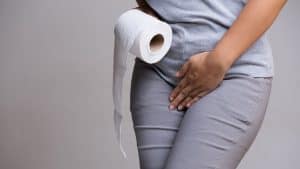
For most people, the problem of bladder and bowel accidents, or incontinence, stems from loss of one or both integral parts of the system that must work together to empty the bladder and the rectum normally and without leakage or accidents: the muscles and the nerves.
Both the bladder and the rectum depend on a complex system of muscles that include sphincters and broad support muscles – what we call “the pelvic floor.” In both women and men, these muscles and nerves can be damaged or lose their integrity in several ways.
Common Causes of Incontinence
Age is statistically the number one contributor to loss of perfect nerve signaling and perfect muscle function. Some studies have estimated a 1% per year decline in the nerve signals to the pelvic floor. For some people, at some point, it becomes just enough of a deterioration to cause accidents.
Childbirth and pregnancy are the next reason these muscles and nerves are injured. Babies passing through the birth canal often tear the muscles in ways that do not show up as problematic until decades later. And during pregnancy and delivery, the important nerve transmission lines can get stretched and injured.
There are also numerous other conditions that contribute to the loss of proper bowel and bladder function and control. These include things like medications, radiation, surgery, cancer, and a broad range of health conditions that affect the nerves and muscles like myopathies, Parkinson’s, and diabetes.
For most of us, the problem starts small, with occasional leakage that slowly becomes occasional accidents, which soon become an every-day problem requiring pads and diapers and always carrying a change of clothes.
Addressing an Embarrassing Condition
Many people are embarrassed to talk about the problem to their doctor, and all too often, neither person realizes the problem can be solved. Sometimes people will bring up bladder leakage, but many times the problem of bowel leakage, or fecal incontinence, is just not discussed. So, let us take a closer look and consider specifically the problem of loss of perfect bowel control.
I will just say a quick word about how the problem of bowel leakage, which affects tens of millions of Americans, varies a great deal in its severity. The treatments also vary to match the severity of a person’s experience.
Some people have an annoying leakage only when they exercise, and they just find embarrassing spots on their underwear when doing laundry. But these individuals are not really bothered beyond that. Over time, however, the problem becomes worse, and many people find themselves having to wear pads, change undergarments often, or carry an extra set of underwear with them at all times.
Worst of all, some people start avoiding the great things that make life fun, like visiting with other people, exercising, and attending events. If it is more severe, the skin around the anal area can become seriously chafed and damaged, leading to fungal or bacterial infections.
Incontinence Solutions
The solutions start with some changes in diet, practicing home exercises, and the use of oral medications, ointment for the skin, and fiber supplements. The reason we start there is that loose consistency stools or diarrhea can be very hard for anyone to control.
With loose or liquid bowel consistency, lots of people will have little or no warning time to get to the bathroom. That same person, however, has plenty of warning time to get to the bathroom if the stools are firmer.
Diet
The strategy is to figure out what change in your diet you can undertake to make the stools firmer. For some people, it is identifying certain foods that cause diarrhea. A common example is dairy products for a person who does not realize they are lactose intolerant.
The first place to start is keeping a food journal for a couple of weeks and to write down the bowel movements of the day along with the consistency of the stools. Also note if there was an accident or leakage.
Fiber Supplements
Hardening the stools can sometimes occur with diet and sometimes by adding powdered fiber in the form of Citrucel or similar products. An important thing to remember here is that no two people are quite alike. I always advise my patients to consider this an experiment for a few weeks.
Medication
Next, we use common medications to firm up the stools: Imodium (loperamide) and Lomotil. These are often helpful and usually something to at least try for a few weeks.
Imodium binds to the receptor in the intestines that is a type of opioid receptor, slowing down the muscle contractions of the intestines. Some people experience dizziness or drowsiness, constipation, dry mouth, or fatigue.
Lomotil, on the other hand, has two active ingredients, and one of them is in a class of drugs called anticholinergics. It has a lot of side effects, especially in older people.
These include dry mouth, constipation, dry mucous membranes everywhere including dry eyes, and difficulty emptying the bladder. Worst of all, in older people these drugs cause confusion, memory loss and depression. We try to avoid these drugs in people over 60 years old for that reason.
Home Exercises
Exercises to strengthen the anal sphincters and pelvic floor have been shown to help somewhat. These can be done at home with Kegel exercises, plus some home exercises including squats and kneeling leg lifts. There are online tutorials, and specialized centers offer more formal training sessions with a therapist.
Biofeedback is a form of exercise in which additional information is gained based on monitoring the muscle activity to help the person better engage the pelvic floor and sphincter muscles. We try to encourage every patient to use these techniques and modalities, and our experience has been that they are helpful as an adjunct therapy but rarely work as a standalone treatment.
The Most Effective Treatment
Most people consult us after the first-tier methods of diet, fiber, anti-diarrheal medication, exercises have not worked. And that is where the good news is: because of better treatments, today we can almost always solve this problem.
The number one most effective treatment for fecal incontinence, and probably the best kept secret in all of medicine, is sacral nerve modulation (SNM). This therapy has been evolving for 25 or 30 years and was the brainchild of bioengineers who thought they could replicate the amazing success of cardiac pacemakers by making a “pacemaker” for the pelvic floor and sphincter muscles.
It turns out that they were 100% correct. The same idea of using a gentle current to restore the pelvic floor muscles and sphincters of the rectum and bladder causes nearly complete correction of the leakage and accidents in most people. This treatment is very much like the placement of a pacemaker, meaning that it is today a minor procedure performed with local anesthetic.
SNM is at least 90% successful in resolving bowel leakage in published, peer-reviewed studies. Medicare and virtually every insurance plan cover it, and the tiny device is placed under the skin in about 25 minutes with a single Band-aid. The newest devices have a battery life of a whopping 15 years.
What About Injected or Surgical Treatments?
Additional treatments include the use of a viscous filler material, or bulking agent, injected directly into the tissues of the anal sphincter. Several years ago, the FDA approved a specially designed dextranomer filler material called Solesta, and the treatment works moderately well.
The injection is performed in the office, and surprisingly, it is not painful. This treatment usually does not completely solve the problem all by itself, but it is a great adjunctive therapy. The substance is inert and not thought to cause any harm, but the body does eventually dissolve it over time, usually anywhere from 6 months to 5 years. There are rare, reported cases of infection, but it is a very benign therapy.
Lastly, there is reconstructive surgery. Amazingly, during my career, surgery has become rare in treating fecal incontinence because sacral nerve modulation works so well. Twenty years ago, it was not uncommon for a person to undergo a complex procedure to overlap and reconstruct the sphincter muscles, and then work on rehab for months. Today, that is very rarely necessary.
As you can imagine, this type of surgery is quite painful, and recovery can be very slow. Wound complications are common. So, it has been a tremendous improvement to have sacral nerve modulation today that has almost eliminated the need for this type of reconstructive surgery.
What if Nothing Works?
It must also be said that there are patients for whom no solution provides an answer and for whom the only good answer is to create a colostomy. This surgery brings the large intestine out to the skin of the abdominal wall and a pouch is worn under one’s clothes. Today, that is a last resort and rarely needed. Some cases of severe cancers and radiation still require a colostomy, but far fewer than in years past.
If bowel or bladder incontinence is an issue for you, it’s important to understand that you aren’t alone and that you have options beyond pads and diapers. I hope you’ll reach out to learn how your symptoms of incontinence can be resolved for good.
Have you silently suffered from one of the two types of incontinence? For how long have you held the issue to yourself? How many different treatments have you tried? What were the results? Which one was the most effective? Please share your story below.
Disclaimer: This article is not intended to provide medical advice. Please consult with your doctor to get specific medical advice for your situation.





